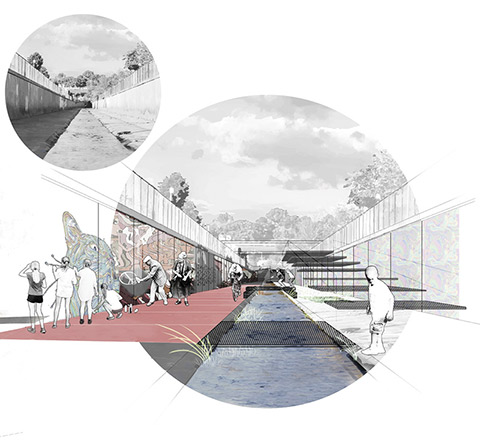Newfoundland native Stephen Brophy, a third-year master’s student at the Daniels Faculty of Architecture, Landscape, and Design, remembers the moment he discovered Toronto’s ravines. “I was shocked to find this incredible, untapped reserve hiding in plain sight,” he says.
Last fall, as part of his studies, Brophy, along with other Daniels students, was asked to come up with ideas for underused sections of Toronto’s river valleys. The goal: to tap into the ravines’ potential as a public resource.
Brophy examined an unappealing 3.5-kilometre stretch of Black Creek Channel that, as he describes it, is “almost completely encased in concrete.” His proposal redesigns the channel as a multi-purpose trail along one side, turns a wall into a “canvas” for public art, allows for skateboarding and provides new entry points for greater public access. He suggests carving out an amphitheatre that could be used for community events and school gatherings, but which would also serve to mitigate floodwaters. Brophy hopes his ideas restore “dignity to a marginalized river and its neighbourhood.”
Prof. Alissa North, who taught the course, says she wanted students to rethink the ravines in light of the city’s aging infrastructure, the need for flood protection and the growing number of people downtown seeking outdoor recreation. City planning staff offered feedback on the students’ projects and will get copies to keep, she says.







No Responses to “ Reimagining Toronto’s Ravines ”
You should know that as nice as this image of a channel of open water is, the City of Toronto is being very careful about open running water in parks and ravines. One unburied river, Burke Brook, was practically a shallow ditch. I work in the Nordheimer ravine, which fed a buried brook that made the grass so soggy it could not be mown. Hence the area was left wet and wetlands were created. I am currently working on a doctorate on the area.